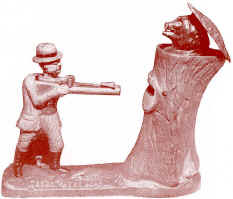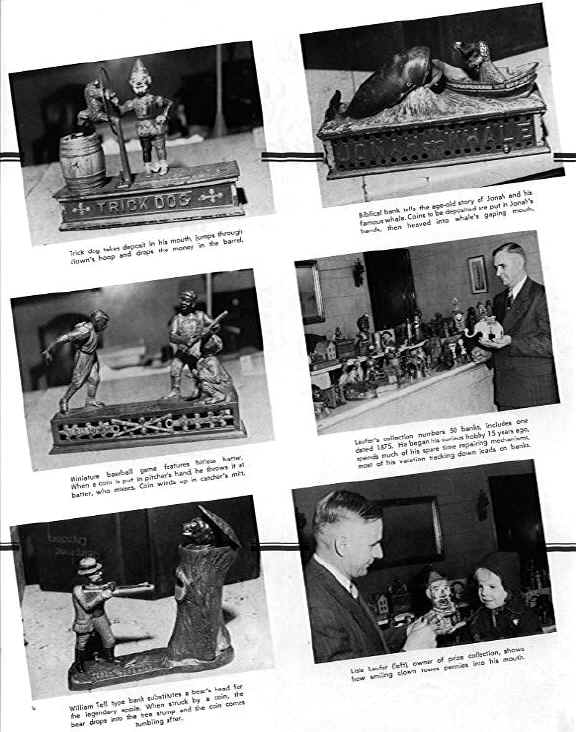WHEELABRATOR DIGEST — Vol. 11, No 3, 1951
| CAST IRON KIDS . . . |
 
|
In the good old days, kids got a big kick out of saving. Not that they were any less tempted by ice-cream or jelly beans than moppets today, but each deposit in an old-time mechanical coin bank was worth a trick or two. There was the William Tell bank, based on the legend of the famous Swiss archer. A penny put in Tell's gun breech tripped a trigger that fired the coin at an apple on a boy's head. The penny knocked off the apple and fell into a tiny castle, which held the coins. Chief character of another toy bank was a hard-working dentist. When a penny was put in his pocket, the dentist yanked out his cast-iron patient's tooth, the patient toppled backward, and the dentist himself went sprawling to the floor. Invented and patented in 1869 by John Hall of Watertown, Massachusetts, the first toy bank proved to be a sure-fire way to make kids save. It was a miniature cast-iron house complete with a doorbell. When the youngster rang the bell, a monkey popped out, took the coin, and vanished into the house. The idea spread like wildfire, and toy banks by the thousands hit the market. In the heyday, the fascinating little gadgets cost from 75 cents to $18 a dozen wholesale. But as costs rose, the banks gradually took on the status of luxuries, and with the drop in sales, manufacturing was halted in 1920. Collectors' items today, the banks range in value from $8 to $200 or more. One of them, in fact, recently sold for $2000. To the collector, age is not so important as paint and mechanical condition, with rarity and the kind of action close behind. One well-known Midwestern collector is J. Lisle Laufer. Five of the banks — plus the collection — pictured on these two pages are his. In Laufer's collection is an 1886 Paddy-and-his pig bank. Originally called the Shamrock bank, the pig kicks a coin into Paddy's mouth while the son of Eire rolls his eyes. Most valuable of Laufer's banks is an 1882 organ-grinder which cost $150 a few years ago. A penny dropped in the music box is rewarded with a tune which the organist grinds out while his bear dances in a circle. The over 150 known U. S. collectors have some rare specimens, dug up in searches through musty attics, old trunks, and even horse barns. One bank, especially apropos at income-tax time, features Uncle Sam. Dressed in stove-pipe hat, blue coat, and red and white striped trousers, Uncle leans on an umbrella waiting expectantly with outstretched hand. When he's given a coin, he drops it in his carpet bag and shakes his whiskers in thanks. U. S. government bonds may be a more profitable way of saving. But you'd have a hard time selling that idea to any 5-year — old lucky enough to have one of these ingenious banks.
Photos and story courtesy of the Chicago Tribune and Walgreen Drug Stores. |

